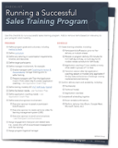If you're part of a sales enablement team, you know the pressure that comes with shaping a sales force into a team of top performers. To facilitate this transformation, a well-thought-out sales training program is essential. And when it comes to the logistics of running a successful program, there are a lot of moving pieces you must attend to.
Here's a helpful summary (and checklist) to ensure you launch a training program that isn't just good, but exceptional.
Define the Program Elements
Think about sales training as a journey, not a destination. Before embarking on any journey, you need a roadmap. By defining the elements of a training initiative, you create the map that sets you up for success. This starts with defining goals and establishing metrics. For instance, if your objective is to increase annual revenue from new accounts by 20%, then your training program should be designed to directly contribute to that goal.
The following are some of the key training elements to define and identify at the outset.
1. Goals and Metrics
Define what success looks like in quantitative and qualitative terms. Metrics could include increased conversion rates, upsell ratios, or reduced sales cycle lengths, for example.
2. Curriculum and Customization
Some industries and organizations will require a curriculum that's tailored to their specific situation, based on markets, customers, solutions, or challenges. Examples of customizations include case studies, scenarios, simulations, role plays, topics, and tools. Identify these customizations well in advance, including resources required and timeline, so they can be integrated into the program.
3. Targeted Participants
Don’t try to pigeonhole everyone into a single program. Group the participants targeted to receive training by cohorts that make sense, such as by role, geographic location, or experience level. For instance, if you have both entry-level and seasoned reps, create training cohorts to deliver targeted and relevant training to each.
4. Manager Involvement
Sales managers are pivotal in sales training efficacy. Define how they'll participate. Sales managers should attend seller training in addition to manager training so they have an understanding of the topics around which they’ll have to support their team.
We also encourage prioritizing training specifically for managers, so managers are well-equipped with tools to coach their teams once sellers have completed their training.
One way RAIN Group does this is with Coaching for Action & Accountability training. This program prepares sales managers to lead a 90-Day Sales Achievement Challenge, which ensures sellers adopt and implement new skills, and maximizes motivation, focus, and execution.
5. Executive Sponsor Involvement
Define the executive sponsor, ideally a member of the C-suite or senior management team, who plays a critical role that can make or break a sales training program.
For example,
- The presence of the executive sponsor during the participant kickoff session lends authority and significance to the program so participants understand the importance of, and commit to, the training.
- A welcome video from the executive sponsor posted on the LMS reinforces this message and offers a personal touch, fostering engagement and commitment.
- Regular communications from the executive sponsor can motivate participants and emphasize the program's alignment with organizational goals.
6. Engagement Champion
Assign an engagement champion and identify the tasks they’re responsible for, such as driving participant engagement. This role can ensure engagement stays high, follow up with participants whose participation is lagging, ensure accountability, and serve as a liaison between other members of the sales enablement team and the executive sponsor.
Create a Training Schedule
Having a detailed schedule helps to execute a sales training program flawlessly. Consider using a platform like Google Calendar, Microsoft Outlook, Airtable, or Monday to slot time for each session, making it visible for everyone involved. Build in, at a minimum, the core elements summarized below, including participant kickoff session, delivery, and coaching.
1. Participant Kickoff Session
Conduct this before the first delivery or module release, to set the tone, build excitement, and share expectations for program participation.
2. Module or Program Delivery
Depending on your training modality, block out time for each training session, be it virtual, in-person, or self-study. For example, we recommend each virtual instructor-led session be no more than 90 minutes in length. An in-person, instructor-led session could be a half-day, full-day, or multiple days. For self-study, we suggest releasing modules to cohorts on a pre-determined schedule.
Read: Rethinking Self-Study for Sales Enablement. >>
3. Application Coaching
Schedule regular coaching sessions to help participants apply what they've learned in real-world scenarios. We typically recommend one hour weekly, or every other week during the duration of the program, or immediately after, in groups of seven or fewer.
4. Confirm Delivery Team
Confirm and gain commitment from everyone on the delivery team, as applicable: facilitators, technical hosts, and application coaches.
5. Confirm Scheduling Logistics
Confirm all logistics as applicable: room rental, equipment, and catering for in-person events, and platform delivery links (Zoom, Google Meet, Microsoft Teams, etc.) for online events.
Define Cohorts
Knowing who, and where, your participants are will greatly influence the program's success. For instance, if your team spans multiple time zones, you'll need to consider this when scheduling live training sessions.
Use a participant list to categorize your participants and adjust scheduling according to time zones.
| First Name | Last Name | Manager's Name | Region/Territory | |
Set Up Learning Management System (LMS)
An LMS, such as Allego, can be your and your sellers’ best friend. Make sure your chosen LMS is set up to be as user-friendly as possible to encourage maximum participation. This is where you can house all participant pre-work, reinforcement, and reference materials.
Prepare by adding all necessary modules, tailoring as needed, and adding notifications or reminders prior to launch.
Prepare Facilitators and Coaches
An effective training session requires preparation. Ensure facilitators review and are familiar with all program materials and that application coaches understand the specifics of what they’ll be coaching.
Facilitator Requirements
Facilitators should undergo a Train-the-Trainer (TTT) Certification and review all relevant materials, including program or module delivery slides, run sheets, videos, tools, and other resources.
Coach Requirements
Coaches should complete a Train-the-Application Coach (TTAC) certification and confirm all coaching session schedules. They should also review content for the modules and topics they’ll be coaching on.
Participant Communications
Clear and continuous communication keeps everyone engaged. For example, send out weekly updates via email summarizing what was covered and what's coming up next.
Create a communication plan that includes calendar invites, notifications, and regular updates to keep participants on track. Use a cascading communication plan for optimal effect.
Determine Evaluation and Reporting
Regular evaluation via metrics and surveys provides a reality check. Use analytics features available in most LMS platforms to track how well participants are absorbing the material.
Monitor engagement reports, conduct pulse surveys, gather feedback from facilitators, and analyze end-of-training evaluations to measure success and areas for improvement. Be sure to capture and review success metrics over the long term that are aligned with your goals.
Plan Training Reinforcement
Training shouldn't end when the formal sessions do. Keep the momentum going with reinforcement activities that support the new skills and behaviors. Use post-training reinforcements such as RAIN Mail or a 90-day Sales Achievement Challenge, to make sure the learning is applied in the field.







